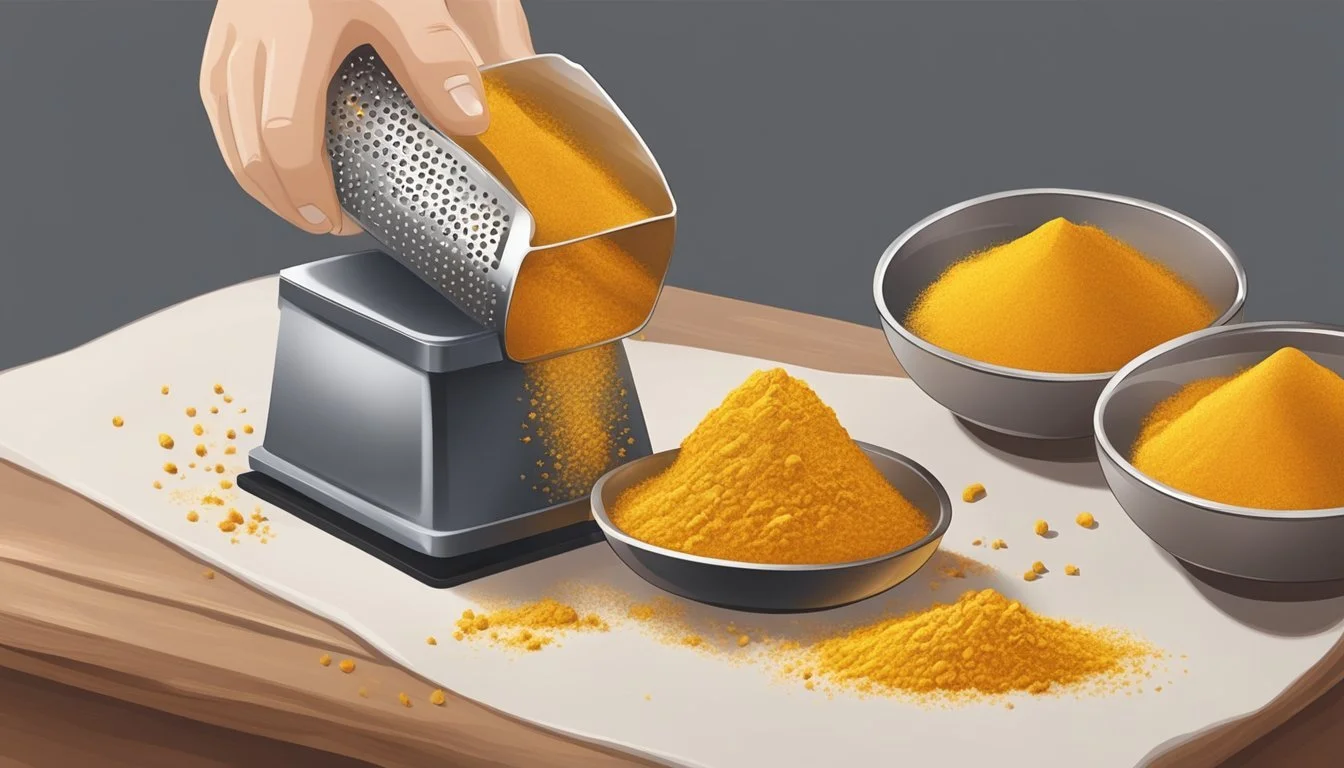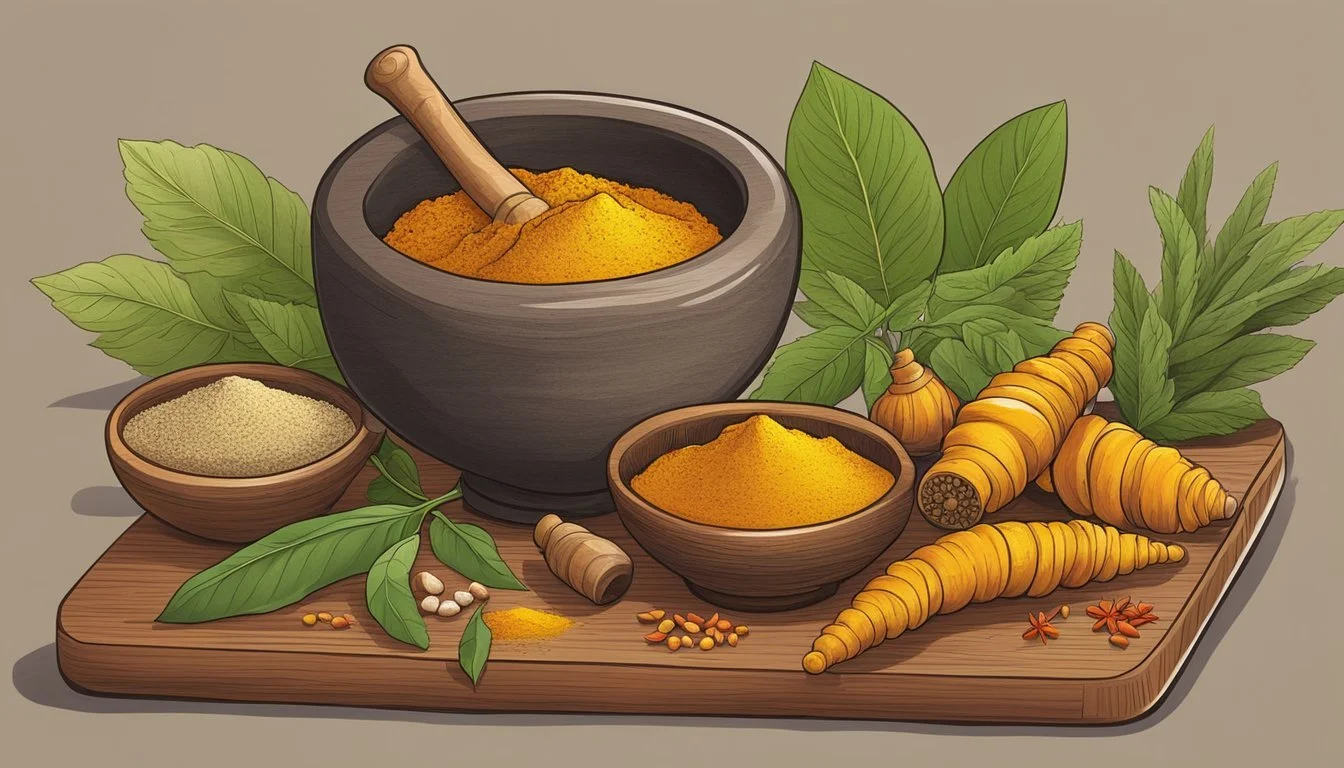How do you eat a turmeric root?
Simple Ways to Incorporate It into Your Diet
Turmeric root, a vibrant yellow-orange spice, is renowned not only for its role in culinary traditions—particularly in South Asian and Middle Eastern cuisines—but also for its health benefits. Extracted from the root of the Curcuma longa plant, it contains curcumin, a compound with potent anti-inflammatory and antioxidant properties. People integrate turmeric into their diets in various ways to leverage these health benefits, which can range from improving digestion to supporting immune function.
Eating turmeric root can be as straightforward as incorporating it into curries and stews, where it adds a warm, earthy flavor. However, for those looking to make it a regular part of their diet, there are several other methods to enjoy this spice. Turmeric can be grated into sautés with fresh greens, simmered into a comforting beverage known as golden milk, or blended into smoothies. Each method not only enhances the flavor of the dishes or drinks but also ensures that the consumers enjoy the maximum health benefits turmeric has to offer.
To ensure the body absorbs the full benefits of turmeric, pairing it with black pepper, which contains piperine, is recommended. Piperine increases the bioavailability of curcumin, making the consumption of turmeric more effective. Additionally, combining turmeric with a source of fat, such as coconut oil or milk, can further improve absorption, since curcumin is fat-soluble.
Understanding Turmeric Root
In this section, we examine turmeric root, known for its vibrant color and extraordinary health properties. The discussion encompasses its botanical identity, culinary versatility, health advantages, and nutritional elements.
Botanical Profile
Turmeric, or Curcuma longa, is a rhizome of the ginger family. Its physical form resembles that of ginger root, with a rough, brown skin covering its deep orange flesh. It contains the active ingredient curcumin, which gives turmeric its characteristic bright yellow color and multiple health benefits.
Culinary Uses
Turmeric's earthy flavor and aromatic scent are prominent in various cuisines. Fresh turmeric root can enhance dishes when grated into salads, sauces, vinaigrettes, and entrees. It's also boiled and powdered for use as a spice in curries and soups. Turmeric's versatility in the kitchen extends to turmeric tea or "golden milk," a combination of milk, turmeric, and often coconut oil, cinnamon, and honey.
Health Benefits
Notable for its antioxidant properties, turmeric root contributes to health through potentially reducing inflammation and improving immune responses. While research is ongoing, the consumption of turmeric is associated with potential benefits in managing arthritic pain, digestive issues, and cognitive health due to the presence of curcumin.
Nutrient Content
Nutrient Presence in Turmeric Curcumin High Antioxidants Abundant Dietary Fiber Present Vitamins Contains Vitamin C and Vitamin B6 Minerals Boasts minerals like iron, manganese, and potassium
The nutritional profile of turmeric is impressive, offering more than just its active components. It is a source of dietary fiber and contains essential vitamins and minerals, supporting overall nutrition.
Preparing Turmeric for Consumption
Eating turmeric root involves proper selection, storage, and preparation techniques. Knowing how to handle fresh turmeric can enhance its flavor and health benefits.
Selecting Quality Turmeric Root
One should look for turmeric roots that are firm and plump, avoiding ones that are shriveled or have soft spots. It is best to purchase turmeric roots from the grocery store or markets with high turnover to ensure freshness.
Storage and Preservation
To maintain the potency of fresh turmeric, it should be stored in an airtight container in the refrigerator where it can last for a few weeks. For extended storage, one may also freeze turmeric root either whole or sliced.
Cleaning and Peeling
Before consuming turmeric, one must wash the root thoroughly under running water to remove any dirt or debris. Using a vegetable brush can aid in this process. After washing, the skin of the turmeric root needs to be peeled off, usually with a knife or spoon, exposing the bright orange flesh inside for use.
Grating Techniques
When using turmeric in cooking, grating is a popular method to break down the root for easier incorporation into dishes. A grater or zester is ideal for this purpose, producing fine shavings that can be evenly distributed throughout a dish, like salad dressings or soups, for instance.
Incorporating Turmeric into Your Diet
Turmeric root can enhance both the flavor and nutritional value of various meals and beverages. Through versatile recipes and infusions, it can be seamlessly added to the daily diet, offering potential health benefits.
Simple Recipes with Turmeric
To integrate turmeric into cooking, one can start by grating the root into a turmeric butter, mixing it with olive oil and herbs for a spread. Turmeric also complements eggs or rice for a simple but flavorful dish. For a quick snack, try energy balls made with turmeric, honey, cinnamon, and coconut.
Turmeric Rice: Cook rice with a teaspoon of grated turmeric and a pinch of salt.
Golden Scrambled Eggs: Mix turmeric into eggs before scrambling for added color and flavor.
Creating Turmeric Infusions
Turmeric infusions are an excellent way to incorporate this root into beverages. A standard turmeric tea involves boiling sliced turmeric in water and allowing it to steep. For added flavor and health benefits, include ginger, cinnamon, or honey. Alternatively, blend turmeric with coconut milk to create a rich, soothing drink.
Turmeric Tea: Simmer turmeric slices in water for 8-10 minutes. Add lemon and honey to taste.
Golden Milk: Combine turmeric with warm coconut milk, a drop of vanilla extract, and sweetener as desired.
Turmeric as a Food Coloring
Turmeric's vibrant yellow color is perfect for naturally coloring food. Stir the root into soups and curries for a deeper hue or blend with olive oil to dress salads. Its use not only adds visual appeal but also imbues dishes with its characteristic warm and peppery flavor.
Curry: Add ground or grated turmeric for a traditional golden tint and earthy taste.
Salad Dressing: Whisk turmeric with olive oil, vinegar, and a touch of sugar for a colorful vinaigrette.
Turmeric Supplements
While the root itself can be used in numerous dishes, turmeric supplements in the form of pills, capsules, or gummies offer a convenient alternative. They often contain a higher concentration of curcumin, the active compound in turmeric, but should be taken as directed to avoid possible side effects.
Dosage: Follow the supplement's label for proper dosage.
Form: Select from capsules, tablets, or liquid extracts based on personal preference.
Maximizing Turmeric's Benefits
Turmeric's active component, curcumin, has well-documented health benefits including anti-inflammatory properties, but it's not easily absorbed by the body. Understanding how to enhance curcumin's absorption can maximize these benefits, which may assist in the management of conditions like arthritis and in the prevention of certain diseases.
Curcumin Absorption
Curcumin is the key compound in turmeric that yields its health benefits, but it has low bioavailability on its own. To improve absorption, pairing turmeric with black pepper is beneficial because black pepper contains piperine, a natural substance that enhances curcumin absorption by up to 2,000%. The optimal way to take advantage of this interaction is by adding a pinch of black pepper to turmeric-containing dishes.
Combining with Other Ingredients
Besides black pepper, there are other ways to boost the biological availability of curcumin. Incorporating healthy fats such as coconut oil into turmeric dishes may increase absorption because curcumin is fat-soluble. Additionally, pairing turmeric with other anti-inflammatory ingredients like ginger can enhance its benefits. Citrus ingredients, such as lemon juice, may also aid in preserving the anti-inflammatory properties of turmeric.
Recommended Dosages
Accurately measuring turmeric intake is crucial for obtaining its health benefits without experiencing adverse effects. When using turmeric as a supplement, typical doses range from 500 to 2,000 mg of curcumin per day. For dietary turmeric, there isn't a specific recommended dose, but a general guideline is 1 to 3 grams of the ground root per day. It's always wise to consult with a healthcare provider before starting any new supplement regimen, especially for individuals with underlying health conditions or those taking other medications.
Turmeric in Traditional and Modern Medicine
Turmeric has long been revered in traditional medicine for its potential health benefits, and ongoing research continues to explore its therapeutic possibilities in the modern medical context.
Ayurvedic Practices
In Ayurvedic medicine, turmeric is a cornerstone herb known for its purported anti-inflammatory and healing properties. Practitioners have used it for centuries, typically employing the root in various forms such as powders, pastes, and infusions. The principal compound in turmeric, curcumin, is believed to support a wide range of bodily functions and is used in the management of conditions affecting the heart, mood, and joint health.
Contemporary Research and Uses
Research in contemporary medicine is validating some of the traditional applications of turmeric while also uncovering new potential uses. Studies indicate curcumin's potential to ameliorate symptoms of colitis and certain forms of cancer. Despite the optimism surrounding these findings, medical professionals caution against potential drug interactions when turmeric is consumed in conjunction with conventional chemotherapy or other medications. Current research is methodically assessing the efficacy of turmeric as a complementary medicine and investigating its side effects to establish safe consumption guidelines.
Complementary Spices and Flavors
Turmeric root's earthy and slight bitterness pairs well with a variety of spices and flavors, enhancing dishes and allowing for cultural versatility in its use.
Enhancing Turmeric Dishes
To augment turmeric dishes, one should consider incorporating complementary spices and flavors. Bold black pepper is not just a flavor enhancer; it also increases the absorption of curcumin, turmeric's active component. Salt brings out turmeric's subtle notes, while ginger adds a piquant warmth that complements turmeric’s robustness. Mustard, often in seed or powdered form, can provide an extra tang and complexity to dishes featuring turmeric root. Integrating cayenne pepper offers a piquant kick, suitable for those who appreciate a bit of heat.
Aromatic curry powder, which commonly includes turmeric, combines various spices to create a complex flavor profile. When creating golden milk, a beverage enjoying widespread appreciation, coconut oil provides a silky texture and slightly sweet taste that balances the spice-laden drink. Here are common pairings for turmeric root:
Black Pepper: for absorption and a sharp kick
Salt: to enhance the natural flavors
Ginger: for warmth and zest
Mustard: for tang and depth
Cayenne Pepper: for spice enthusiasts
Coconut Oil: for creamy, rich concoctions
International Cuisine
In the realm of international cuisine, turmeric root is a mainstay. It adorns Indian curries with its golden hue and earthy tone. The spice blend is integral to the flavor profiles of Indians cuisine, providing body and warmth to countless recipes. Lemon can often be found brightening these complex, spice-driven dishes with a refreshing, citrusy note.
Outside of Indian cooking, turmeric root can transform greens such as kale, imparting an intriguing flavor and healthful twist to the dishes. Incorporation of turmeric and complimentary spices into the culinary practices of various cultures continues to evolve, infusing meals with its distinctive character and potential health benefits.
Potential Risks and Interactions
Eating turmeric root is generally considered safe for most individuals, but it can have side effects and interact with certain medications. It is important to be aware of these potential risks to avoid adverse health effects.
Side Effects of Turmeric
Turmeric may cause side effects, particularly when consumed in large quantities or in supplement form where concentrations are higher. Some individuals might experience digestive issues such as stomach upset, nausea, dizziness, or diarrhea. Allergic reactions, although rare, can manifest as rash, hives, or abdominal pain.
Digestive discomfort: This is commonly reported with high doses of turmeric.
Allergic reactions: Symptoms might include skin irritation or gastrointestinal distress.
Interactions with Medications
Turmeric can interact with certain medications due to its impact on how they are absorbed and metabolized. This is especially significant for drugs that require specific levels to be effective or have a narrow therapeutic index. The bioactive compound in turmeric, curcumin, can affect the efficacy and processing of these drugs.
Blood-thinners: Turmeric may enhance the effects of medications like warfarin, increasing bleeding risk.
Diabetes medications: It can intensify the effects of drugs that reduce blood sugar, leading to hypoglycemia.
Antacids: Turmeric can interfere with drugs that reduce stomach acid, impacting their effectiveness.
It's important for individuals on any regular medication to consult a healthcare provider before introducing high doses of turmeric or curcumin supplements into their regimen due to these potential drug interactions.
Culinary Inspiration
Exploring the versatility of turmeric root in cooking crosses global boundaries and creative culinary techniques. From traditional Indian curries to innovative turmeric-infused smoothies, turmeric offers a unique flavor and a host of health benefits that inspire a myriad of dishes.
Global Turmeric-Inspired Dishes
Turmeric root features prominently in Indian cuisine, with its use in curries and lentil dishes being particularly well-known. One can find turmeric adding its golden hue and earthy flavors to a variety of curries, ranging from mild kormas to robust vindaloos. In addition to curries, it imparts a vibrant color and a subtle, warm taste to rice dishes such as biryani.
Southeast Asian recipes often include fresh turmeric as well. It is an essential ingredient in many soups, including the comforting Vietnamese Pho, where it melds with other aromatics to create a richly flavored broth. Across these cuisines, turmeric is not just prized for its flavor but also for its reputed anti-inflammatory properties.
Innovative Turmeric Recipes
Chefs and home cooks alike have embraced turmeric's potential by incorporating it into an array of innovative recipes. Golden milk, or turmeric tea, is a comforting drink made by simmering milk with grated turmeric root and spices like green cardamom, ginger, and cinnamon. The inclusion of a fat source, such as coconut oil, is suggested to enhance turmeric absorption.
Turmeric finds its way into modern kitchen creations including smoothies and breakfast foods. A pinch of turmeric can transform a regular smoothie into a health-boosting beverage. For a breakfast twist, one can sprinkle turmeric over eggs such as omelets or scrambled eggs for an antioxidant boost. Even everyday vegetables can be elevated with turmeric, either by roasting them with a dusting of turmeric powder or by adding fresh grated turmeric to a stir-fry for an extra dimension of flavor.
Lifestyle and Turmeric
Turmeric root is incorporated into lifestyles not only as a culinary spice but also as a component for wellness and self-care due to its health benefits, particularly its anti-inflammatory properties.
Turmeric in Daily Life
Integrating turmeric into one's daily life can boost nutrition with minimal effort. Individuals can:
Consume turmeric in its natural root form by grating it into salads or blending it into smoothies.
Prepare a turmeric tea or wellness shot by simmering slices of the root and combining it with ingredients like ginger or lemon, which is ideal for soothing a cold.
Infuse turmeric in cooking, such as by adding it to curries, rice dishes, or as a vibrant garnish on top of avocado toast.
Wellness and Self-Care with Turmeric
Turmeric's role in wellness and self-care spans several applications:
As a drink, turmeric can be whisked into warm milk along with honey to create a comforting liquid known as "golden milk," beneficial before bedtime.
Incorporating turmeric in liquid form, such as in juices or shakes, provides a quick and convenient method for ingesting its anti-inflammatory compounds.
For those partaking in wellness rituals, consuming turmeric can be a part of a balanced diet aimed at maintaining health and combating inflammation.
Shopping and Storing Tips
When purchasing turmeric root, one needs to select high-quality specimens and store them properly to maintain freshness and potency. Here's how to navigate both processes effectively.
Buying Turmeric Root
When shopping for turmeric root at the grocery store, one should look for firm roots with smooth, vibrant skin devoid of wrinkles, which can signify age and loss of flavor and potency. Fresh turmeric root should resemble ginger root in texture and firmness. Avoid roots that are soft, shriveled, or moldy.
Storing Turmeric Properly
After purchase, turmeric root should be stored in a way that prolongs its lifespan and preserves its quality:
Refrigerating: Store turmeric root in an airtight container or ziplock bag in the refrigerator, where it will keep for about a month.
Freezing: For longer storage, one can freeze turmeric root. First, wash and pat it dry completely. Wrap the root in paper towels and place it in an airtight container or sealable freezer bag before storing it in the freezer. Frozen turmeric root can last up to six months.
Note: If one notices any signs of deteriorating quality, such as mold or a soft texture, it's best to discard the affected parts or the entire root to prevent the spread of spoilage.
DIY Turmeric Products
Creating DIY turmeric products allows individuals to harness the benefits of turmeric for internal consumption and topical use. These homemade products often utilize readily available ingredients and require simple preparation techniques.
Homemade Turmeric Pastes and Oils
Homemade Turmeric Paste:
Ingredients: Raw turmeric root, water (or oil for increased absorption)
Instructions:
Peel and chop fresh turmeric root.
Blend the chopped turmeric with a small amount of water or oil—like coconut or olive oil—in a blender to form a smooth paste.
Note: A homemade turmeric paste can be used as a base for cooking or as a wellness supplement.
Homemade Turmeric Oil:
Ingredients: Ground turmeric or finely grated turmeric root, carrier oil (e.g., coconut oil, olive oil)
Instructions:
Combine the turmeric with a carrier oil in a ratio that suits your preference for concentration.
Heat the mixture gently for a few minutes, and then allow it to cool.
Strain the oil through a cheesecloth to remove solid particles.
Usage: The oil can be incorporated into salad dressings, sautéed dishes, or taken by the spoonful.
Turmeric-Based Skin Care
Ingredients: Turmeric powder, natural yoghurt or honey
Recipe:
Mix 1 teaspoon of turmeric powder with 1 tablespoon of yoghurt or honey to form a paste.
Apply to the face and leave it for 10-15 minutes before washing off.
Benefits: Turmeric based masks can help to brighten the skin and improve complexion due to turmeric's antioxidative properties.
Turmeric Body Scrub:
Ingredients: Turmeric powder, granulated sugar, coconut oil
Recipe:
Combine equal parts of turmeric powder and granulated sugar.
Add coconut oil to bind the ingredients together into a scrub consistency.
Method: Use the scrub to exfoliate the skin during a bath or shower to help remove dead skin cells and promote healthy skin.
Conclusion
Turmeric root, with its distinct yellow hue and earthy flavor, can be incorporated into one’s diet in multiple ways. Fresh turmeric can be grated into soups, stews, or sautés, adding a warm and slightly peppery taste. It is also commonly simmered with milk, along with a dab of coconut oil or honey, to make a comforting beverage known as golden milk.
When consuming turmeric, it's important to consider its nutritional benefits. It contains curcumin, a compound with anti-inflammatory properties, which may aid in reducing joint pain and swelling. Turmeric has been a staple in traditional medicine, supporting a variety of health benefits.
In tea: Turmeric slices can be steeped to create an invigorating tea.
With greens: Freshly grated turmeric can be sautéed with leafy greens for an added nutritional punch.
For optimal absorption, it's advisable to combine turmeric with black pepper. Piperine, a component of black pepper, enhances the bioavailability of curcumin. A balanced diet including turmeric should be maintained, as high concentrations, often found in supplements, may lead to undesirable side effects.
Those with health conditions or on certain medications should consult a healthcare provider before incorporating high doses into their regimen, as turmeric can interact with other substances. Those who are allergic should avoid turmeric, as it can cause adverse reactions such as rashes or abdominal pain.
In culinary uses, turmeric imparts not only a vibrant color but a depth of flavor and potential health benefits, positioning it as a beneficial addition to a nourishing diet.
References
When discussing how to consume turmeric root, it is crucial to reference credible sources that provide accurate information and guidelines. These references have informed the content of the article and offer further insight into the topic:
FoodHow.com provides a recipe for enhancing the absorption of turmeric root by incorporating it into milk with a mix of other spices. The combination of these ingredients is suggested to simmer for optimal flavor infusion.
Johns Hopkins Medicine discusses the safety profile of turmeric root and notes possible side effects such as rashes, hives, or abdominal pain in cases of allergies or high concentrations found in supplements.
wikiHow Life presents a variety of ways to incorporate turmeric into meals, such as sautéing with greens or using it in recipes.
Further Exploration:
The wikiHow Life website offers additional ideas for consuming raw turmeric, including preparing a cold golden milk drink.
Another accessible option is making turmeric tea or "golden milk," a comforting beverage blending milk with turmeric and optional sweeteners and spices for enhanced taste.
The user should note that while turmeric is commonly used as a spice and believed to have health benefits, it is essential to consume it in moderation and be mindful of individual allergies or dietary restrictions. For personalized health advice regarding turmeric intake, they should consult with a healthcare provider.













